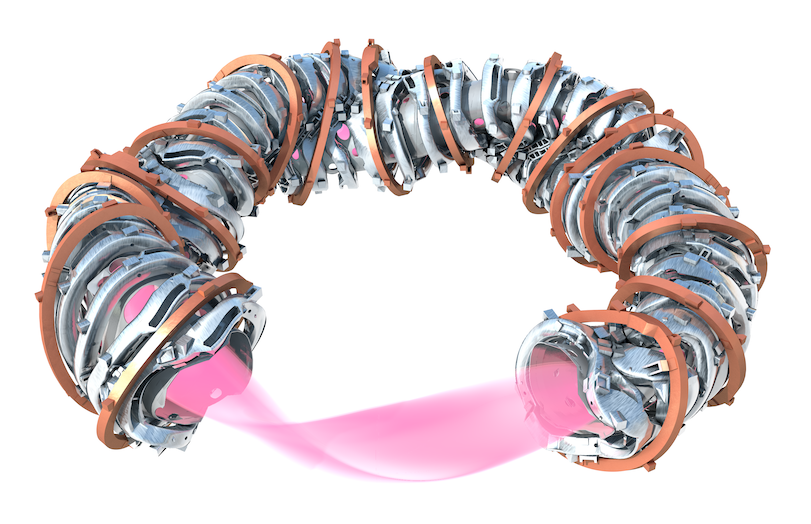
Francesco Sciortino (left) and Lucio Milanese (right) at the offices of Proxima Fusion in Munich, Germany.
Photo: Lucio Milanese
June 27, 2023
Much like the flowing coils of the fusion device they plan to build, friends and MIT alumni Francesco Sciortino (Physics, PhD ’21) and Lucio Milanese (NSE, PhD ’23) took an unusual route to arrive at their latest challenge. When the pair graduated from Imperial College London in 2016, they had already spent two years on the same physics course track and shared a year abroad at the Swiss Federal Institute of Technology in Lausanne. Then it was off to MIT for the next leg of their journey. This year has been a particularly intense whirlwind: at the end of January, they and three others founded Proxima Fusion, the mission of which is dead simple, according to Milanese: “Nothing other than fusion on the grid.” Their concept is compelling enough that in March they received €7 million in pre-seed funding from private investors, and by April, Proxima Fusion was settled into its new home in Munich, Germany.
Fusion is the process that makes our sun burn and stars shine, occurring when light elements fuse into heavier elements and release incredible amounts of energy. Fusion could be the ultimate source of near-limitless, affordable clean energy, a possibility that has recently spurred unprecedent investment by private industry. If implemented fast enough, fusion might even keep us from the worst effects of climate change. Proxima Fusion’s founders are racing toward that goal, aiming for a prototype capable of producing more energy than it consumes by 2031, and a commercially viable power plant by the end of the 2030s. If the shockingly short ramp from the company’s conception, to founding, to funding, to launch is any indication, they might just make their deadline.
Historically, fusion scientists have favored the donut-shaped tokamak as the best design for a commercial fusion power plant. At the Plasma Science and Fusion Center (PSFC) where Sciortino and Milanese did their PhD research, a series of tokamaks have operated over the years, the latest of which was Alcator C-Mod, in service from 1993 to 2016. The straightforward shape of tokamaks makes them (relatively) easy to engineer and build; however, that ease comes with performance-affecting quirks that scientists are still working to conquer. While at the PSFC, Milanese and Sciortino studied plasma turbulence and particle transport, gaining an understanding of the challenges associated with the presence of large plasma currents in tokamaks.
Fortunately, there is a way to circumvent the challenges inherent in tokamak fusion power plants: build stellarators instead.
The Max Planck Institute for Plasma Physics (IPP) where Francesco did his postdoc is the only facility in the world where one can find both a large tokamak and a large stellarator under one metaphorical roof. If you’ve never seen a stellarator fusion device, just imagine what a hula hoop would look like after taking a trip through a Gaudi fever dream. A stellarator’s organic-yet-alien torus shape comes with distinct advantages; for example, unlike tokamaks, a stellarator can run indefinitely rather than in pulsed bursts, which subjects the device to much less wear and tear. Stellarators’ tortured curves and lack of a centrally located solenoid allow one to construct a device with much greater stability. The downside is stellarators are remarkably difficult to design and build. 
Such high degree of difficulty didn’t deter Sciortino and Milanese, though. Dennis Whyte, the Director of the PSFC and one of their professors said of their choice, “Building a successful commercial stellarator is going to require a mix of innovative physics and really clever engineering. That balance of skills is a hallmark of PSFC students. Stellarators have a particular challenge in the level of precision needed in the physics and engineering tolerances. It will be a challenge that Lucio and Francesco are up for.”
“It’s hard to overstate the influence that MIT had on our development, both technically and entrepreneurially,” said Milanese. In 2018 he and Sciortino had seen the genesis of Commonwealth Fusion Systems (CFS), a spin-off of the PSFC co-founded by five MIT alumni and Professor Whyte. “MIT is a place where people are not scared of showing up, of trying something new, or of being proven wrong.” While MIT is famous for its many successful spinouts, the IPP, founded in 1960, has spun out exactly one: Proxima Fusion.
The easy part might have been the launch; now that they’re up and running, Proxima’s real work—delivering a power plant design that outperforms any other fusion device—is beginning.
“We are well aware that what’s ahead for Proxima is very challenging.” But, Sciortino added, paraphrasing Paul Sabin, “Betting against human ingenuity is often a losing proposition.”
A computer-generated look at the inner coils of the Wendelstein X-7 stellarator housed at the Max Planck Institute for Plasma Physics.
Image credit: Max Planck Institute for Plasma Physics
Topics: Magnetic fusion energy, Technology & engineering, Tokamak & stellarator collaborations